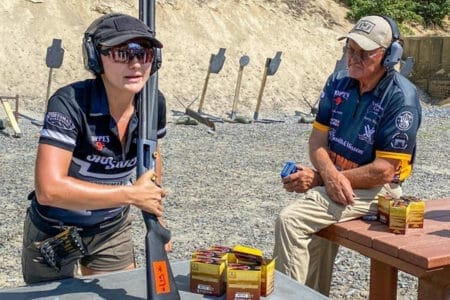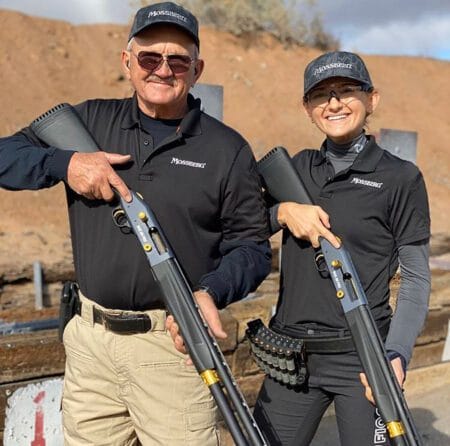2010-2012 Three-Position Air Rifle Rules Now Available
Free for AmmoLand Shooting Sports News Readers.

CAMP PERRY, OHIO – -(Ammoland.com)- The 2010 – 2012 8th Edition National Standard Three-Position Air Rifle Rules were released in September 2010.
The National Three-Position Air Rifle Council•, which governs most three-position air rifle shooting in the USA, releases a revised rulebook every two years.
Rule changes are based on decisions made by the Council, which held its most recent annual meeting this past June. The 2010-2012 version of the rules includes several rule clarifications that are based on interpretations issued during the last two years. A few changes were also made to bring three-position rules in line with International Shooting Sport Federation (ISSF) rule changes.
Rule changes concerning three-position equipment were also few in number. A new Daisy replacement stock for the M888/887 CO2 air rifles was approved. This stock features an adjustable cheek-piece and butt-plate (once adjustments are set, they cannot be changed during a sporter class competition). Authorization was given for match sponsors to allow “lower-cost air rifles” at the grassroots level. New ISSF standards for checking the size of shooting trouser seat pads and the flexibility of shooting shoes were incorporated into the rules (precision class clothing). Standards for checking blinders and visors were established (see #3 below).
The following highlights three of the most significant rule changes.
1. Rule 8.6.3 – Ties for Last Position in Final. The new rulebook now gives match directors the option of conducting a shoot-off to decide ties for the last position(s) in an eight-person final. This addition was made to be inline with the tie-breaking procedures now used by the ISSF. At this year’s National Three-Position Air Rifle Junior Olympic Championship, this rule was added to the program so it could be showcased at a National 3PAR event. In the precision event, no shoot-off was necessary, but a shoot-off was required to determine the last qualifiers for the sporter final. This was the first council shoot-off and the event was well received by competitors and spectators. Under the new rule, national level matches are required to hold shoot-offs, but local matches can still break these ties by using tie-breaking procedures found in Rule 8.6.1. Information about whether or not a match will hold a shoot-off must be included in the match program. The shoot-off is run similar to a final, and must be conducted as soon as possible after qualification scores are posted. Any shooters with tied qualification score (not including x-count) for the last place(s) in the final will then compete in the shoot-off. This can be as few as two shooters, or there could be several shooters with the same numerical score. Shooters are first given a five-minute preparation and sighting period. They then shoot five shots on command, “FOR YOUR FIRST/NEXT COMPETITION SHOT…LOAD…ATTENTION, 3-2-1 START.” Shooters have 75 seconds to fire each shot. Unlike a final, scores are not announced after each shot is fired. After all five shots are completed, the range officer will announce the five-shot totals for all shooters in the shoot-off. If possible, shoot-offs should be scored in tenth ring values (requires electronic targets or Orion VIS scoring). If ties remain, single shots are fired on command until the tie is broken.
2. Rule 8.5.5 – Protests of VIS Targets. Visual Image Scoring (VIS) such as the Orion Scoring System, has revolutionized the scoring of paper targets by increasing the speed, consistency and accuracy of scoring. Like any new system, the rules concerning its practical use have continued to change as experience is gained and situations arise that warrant change. Rule 8.5.5 concerns the protest procedures for shots scored by VIS targets. Instead of challenging the entire target as was the rule in the previous edition of the rulebook, the new rule states that a specific shot or shots must be protested. Obvious errors, such as when the computer program picks up the wrong shot location, multiple shots on the same bull, or when a paper tear is picked up as a shot, can be brought to the attention of the Statistical officer and changed without an official challenge. If the competitor believes that a shot without an obvious error was scored incorrectly the shot must be officially protested. Shooters must be very confident in their protests, however, since there is now a two-point penalty per protest if the whole number value of the shot does not increase. The Council’s decision to impose a two-point penalty for lost score challenges was adopted so that the score protest procedures for VIS scoring would be essentially the same as they are for electronic (EST) targets where there has been a two-point penalty for lost score protests for several years. The two-point penalty also is intended to avoid slowing down the match when some competitors attempt to “buy points” by protesting several shots that must then be rescored. The incentive is now very high for shooters to only challenge shots that they are convinced should be a higher point value. If stated in the match program, a protest fee (of $3 or less) can be collected for each protest. If a shot is protested, the scan for that shot is then re-evaluated with a “protest algorithm.” If the shooter is granted the point, the fee is returned and score adjusted. If the original score remains the same, the fee is not returned and two points must be deducted from the score of the protested shot. All results of protests are final and cannot be appealed.
3. 4.7.7 – Headgear and Blinders. Competitors now need to be more mindful of the way in which they wear their caps or visors while shooting. If a hat is pulled down too far, the sides may be considered side blinders. While side blinders are permitted under Rule 4.7.9, they are restricted to being no more than 40mm deep (downward direction), and also must not extend past the center of the forehead as seen from the side. To prevent cap bills and visors from being pulled down so that they become illegal side blinders, Rule 4.7.7 was updated to state that when a hat or visor is worn, the area on the forehead between the eyebrows must be visible from the side of the shooter. Range officers will be able to check by coming to the side of shooter in position. From that viewpoint, they can quickly determine whether the hat or visor is high enough on the shooter’s head. It is also important to note that the cap or visor is not permitted to touch the rear sight. Some floppy visors or hats may hit the rear sight, so shooters should place their hats in such a way that they do not touch the sights.
The 2010-2012 8th Edition of the National Standard Three-Position Air Rifle Rules, with the most recent changes approved by the National Three-Position Air Rifle Council, is now available in printed version or as a downloadable *.pdf file. The new rules may be accessed immediately through the CMP website at https://www.odcmp.com/3P/Rules.pdf. Printed copies of the new rulebook may be ordered from the CMP at a cost of $2.00 each.
The National Three-Position Air Rifle Council continues to urge all coaches, competitors and match sponsors who have questions about the three-position air rifle rules to contact the National Council Rules Hotline. If you have questions or recommendations concerning the rules, contact Vicki Donoho at [email protected] or 419-635-2141, ext. 1102.
2010-2012 National Standard Three-position Air Rifle Rules
Alternately you download the new rules at https://www.odcmp.com/3P/Rules.pdf
About:
The National Three-Position Air Rifle Council includes representatives of the American Legion, Boy Scouts of America, CMP, Daisy Shooter Education Program, National 4-H Shooting Sports, U. S. Army Marksmanship Unit and the Army, Marine Corps, Navy and Air Force Cadet Commands.




